You know Shopify is a big deal. Millions of merchants use it every day. On a global scale, it has grown from a fledgling Canadian startup to a behemoth amongst ecommerce platforms. But how big is Shopify Inc., really? In this article, we'll complete a thorough analysis of current Shopify revenue, statistics, and growth potential to show the successes and challenges Shopify has experienced over the years.
The aim is to explain the details behind the hype, while also providing you with information about the platform that so many merchants have entrusted with their entire businesses.
We've done our best to keep this post updated as new Shopify revenue, usage, and grown statistics come in, and we'll continue providing you with the most up-to-date statistics possible. Keep reading to learn all about Shopify revenue, usage stats, and more!
Top Facts and Stats About Shopify
Although the following sections provide in-depth detail about Shopify revenue and usage statistics, here are some of the most important facts and stats to gain a deeper understanding of Shopify:
- Shopify revenue was $3.231 billion in 2021, showing an increase of 86% over the past two years.
- Total value of transactions processed through Shopify stores leapt to $79.5 billion in 2021.
- Over 1.75 millions merchants use Shopify as their primary platform for selling online.
- Over 457 million buyers came to and shopped at Shopify stores.
- Shopify boasts over 7,000 apps in its App Store.
- Shopify offers over 100 themes in its Theme Store, along with 3-4 variants for each of those themes.
- Shopify employs and contracts over 7,000 people.
- Three Canadians started Shopify in 2004. They launched it in Ottawa, Canada as a startup experiment after they had below average shipping cart experiences for snowboarding equipment.
- Shopify's ecommerce platform market share has increased to reach 32% in the United States. WooCommerce is the only other ecommerce platform close to that market share. Shopify beats out all other competitors like Bigcommerce, Magento, Wix, and Squarespace.
- Experts attribute much of Shopify's success to its affiliate program, which awards affiliates with an average of $58 per new, paid user.
Our primary source is the Shopify Financials page as prepared by Shopify CFO Amy Shapero and Shopify President Harley Finkelstein.
Shopify Revenue Highlights
Shopify revenue hit $1.124B in the third quarter of 2021.

Combined with first and second quarter revenue reports, total Shopify revenue for 2021 reached $3.231B, its highest-earning year of all time.

Compared to the last year, Shopify revenue increased by 57%. In fact, the first time Shopify saw quarterly revenue over a billion dollars was in 2021.
Shopify has seen a consistent growth in revenue over the past years, often doubling its performance from previous years:
- 2021: $3.2B
- 2020: $2.9B
- 2019: $1.6B
- 2018: $1.1B
- 2017: $673.3M
- 2016: $389.3M
- 2015: $205.2M
Recurring Monthly Shopify Revenue
Shopify reports recurring revenue as a subset of total revenue, factoring in its regular subscription fees from merchants that come in on a monthly basis. They make the calculation by simply averaging the monthly subscription fee from the total number of merchants currently using its system.
The $98.8M in recurring revenue at the end of Q3 in 2021 was an increase from the $82.61M in 2020. Although significantly lower than total revenue, that's a number that Shopify looks at to guarantee consistent cash flow, and to ensure growth in subscribing merchants.
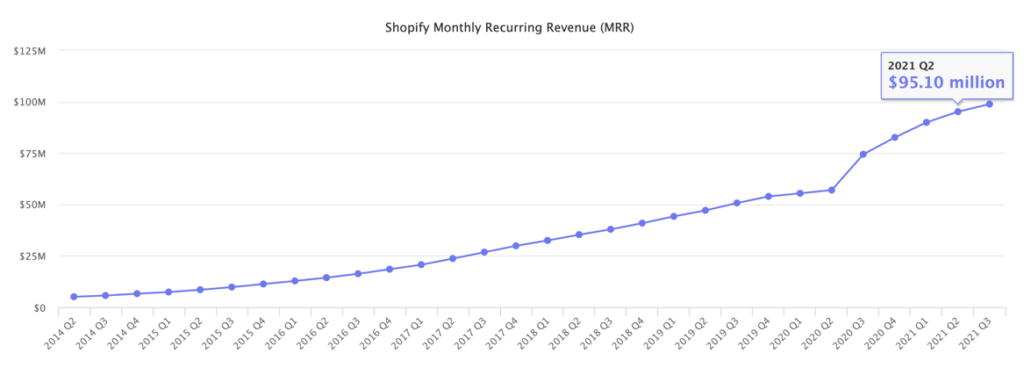
Here's a breakdown of monthly recurring Shopify revenue from past years:
- 2021: $98.8M
- 2020: $82.6M
- 2019: $53.9M
- 2018: $40.9M
- 2017: $29.9M
- 2016: $18.5M
- 2015: $11.3M
Gross Merchandise Volume
Gross merchandise volume takes into account the dollar amount of merchandise sales numbers for all Shopify stores. These numbers don't directly contribute to Shopify's full-year revenue (seeing how it's the money that went to merchants) but it still shows the growth of payment processing revenue and usage from Shopify's perspective.
At the end of 2021, Shopify reported $121.3 billion in gross merchandise volume, meaning that Shopify facilitated that amount of money in transactions for merchants. That's an increase from $119.6 in 2020, although not as large of a jump as they saw from 2019 to 2020 (where they saw a 40% increase).
The latest quarter (not the entire year) had a GMV of $41.8B.
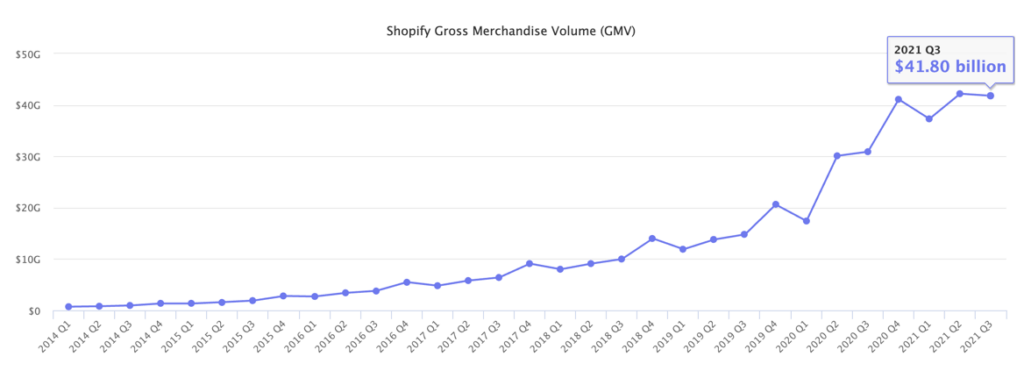
Total gross merchandise volume from previous years include:
- 2021: $1.13B
- 2020: $119.6B
- 2019: $61.1B
- 2018: $41.1B
- 2017: $26.3B
- 2016: $15.4B
- 2015: $7.7B
Regional Shopify Revenue
Shopify tracks where its revenue comes from by looking at merchant locations. It's a fairly general look into regional revenue, considering they only focus on continents, and they already know that most of the revenue comes from North America (primarily the United States).
Shopify gets 73% of its revenue from North America, where 56% of its merchants are located.
Other revenue comes from the following:
- EMEA (Europe, Middle East, and Africa): 16% of its revenue
- APAC (Asia Pacific, Australia, and China): 10% of its revenue
- LATAM (Latin America): 1% of its revenue
The most recent reporting tells us the revenue breakdowns from each region:
- North America: $2.2B
- EMEA: $454.3M
- APAC: $292.2M
- Latin America: $36.1M
Shopify Revenue for Subscription Solutions
Shopify revenue for “subscription solutions” includes any subscription fees like platform subscription fees, themes, apps, domains, and POS Pro fees. It's a special breakdown of revenues so that investors can identify how Shopify makes its money.
Shopify reported $336.3M in Q3 of 2021 for subscription solutions, along with a total of $654.9M for the previous two quarters combined, making a grand total of $991.2M in revenue for 2021 in the subscription solutions category.
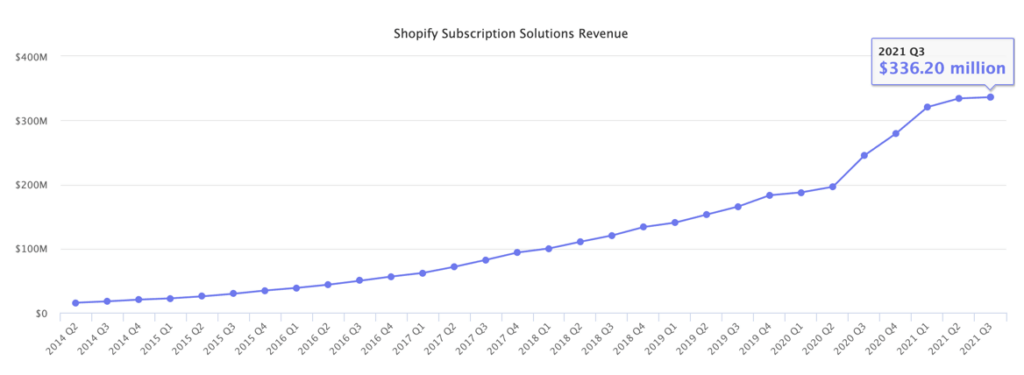
That's an increase in subscription solutions revenues compared to the past year, and a clear sign that this sector of Shopify's business has grown over time:
- 2021: $991.2M
- 2020: $908.7M
- 2019: $642.2M
- 2018: $465M
- 2017: $310M
- 2016: $188.6M
- 2015: $111.9M
Shopify Revenue for Merchant Solutions
With Shopify Payments, Shopify provides payment processing services for many of its merchants, which the company lumps into the “merchant solutions” category when reporting its revenues. The merchant solutions revenue also includes advertising revenue, referral fees, and its point of sale hardware sales. Essentially, this brings together its profits from services that aren't recurring but still assist merchants.
Surprisingly, the merchant solutions category makes up for about 68.9% of Shopify's total revenue, most likely due to the constant inflow of payment processing fees. The total revenue from merchant solutions in 2021 was $2.287B.
The final quarterly report from Q3 in 2021 was 787.5 million.
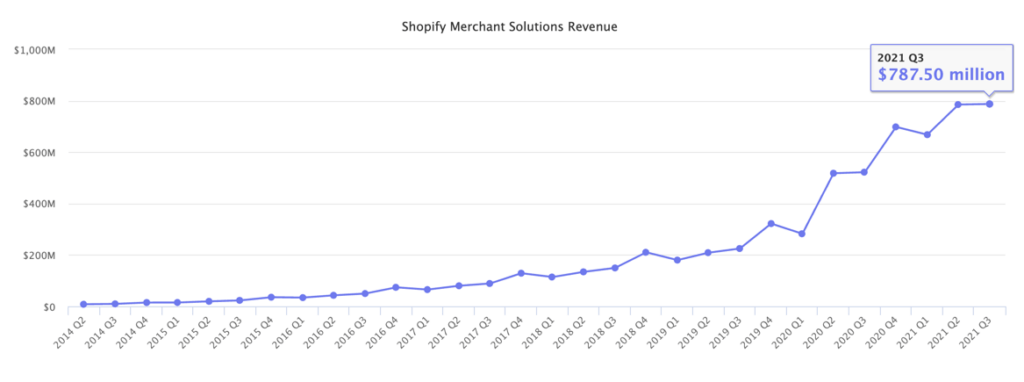
Much like revenues from the subscription solutions category, the merchant solutions number has increased over the years:
- 2021: $2.287B
- 2020: $2.02B
- 2019: $933.9M
- 2018: $608.2M
- 2017: $363.3M
- 2016: $200.7M
- 2015: $93.25M
The Future Outlook of Shopify Revenue and Growth
In its recent reports, Shopify has stated that it expects to continue its growth into future years, but at a slower rate when compared to 2020. The COVID pandemic and various other factors pushed revenues much higher during that time period, and things are leveling out.
Here are some notes from Shopify regarding the future:
- They expect rapid growth in gross profit dollars in the near future as they hire more engineers, expand into more commercial talent, and improve on marketing.
- Adjusted operating income for 2021 is expected to be higher than 2020.
- The fourth quarter often contributes the highest level of revenue throughout the year, and Shopify expects that trend to continue.
- Shopify projects that revenue growth in the subscriptions solutions category to thrive due to more global merchants joining the Shopify platform.
- They expect growth rates (from a percentage perspective) of merchant and subscriptions solutions in the future to match each other closer than the higher numbers they saw in 2020, which saw higher numbers due to the surge in online (and offline) entrepreneurs from the COVID pandemic. The year of 2020 was an outlier, and they don't expect this to repeat.
- Growth in the merchant solutions category will be driven by GMV growth from new merchants joining up, existing merchants, along with growing product offerings like Shopify Shipping and Shopify Capital.
Shopify Traffic and Usage Statistics
This section takes into account metrics for market share, traffic, and usage.
Shopify Market Share
We can calculate market share in multiple ways, so it depends on how we look at it. One method is by factoring in gross merchandise volume and comparing Shopify merchants to merchants selling on other marketplaces. This makes it seem like Shopify is a marketplace in itself, which isn't entirely true, but it is a viable metric considering many merchants only sell on places like Amazon and eBay.
From the marketplace gross merchandise volume perspective, Shopify stores in the US take up 8.6% of the entire market share.
Here's where that stacks up:
- Amazon: 39%
- Shopify: 8.6%
- Walmart: 5.8%
- eBay: 4.9%
- Apple: 3.5%
Another way of looking at market share is by analyzing the most popular commerce platforms used by online merchants. From that vantage point, Shopify has recently surpassed WooCommerce to become to most popular ecommerce platform in the US:
- Shopify: 32%
- WooCommerce: 22%
- Wix Stores: 14%
- Squarespace Add To Cart: 11%
- Ecwid: 5%
- Other: 16%
Source: Oberlo
Number of Shopify Sites
69.67% of Shopify sites are registered in the United States. On a global scale, over 3.76 million live websites currently operate on the Shopify ecommerce platform.
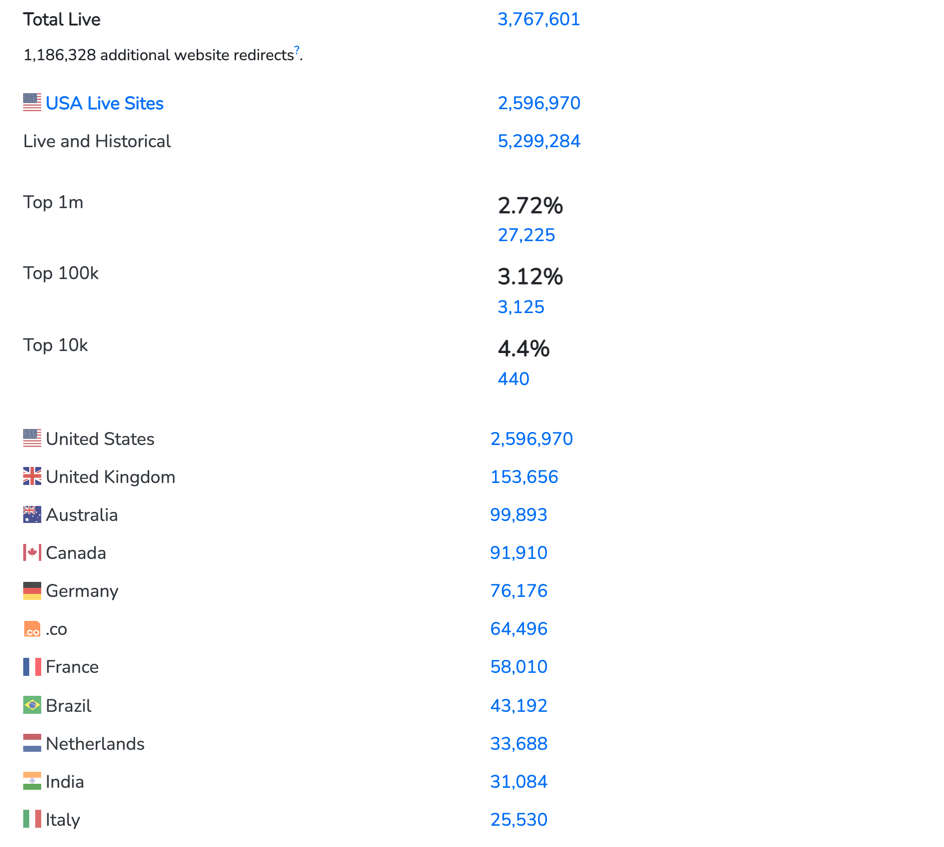
The United Kingdom and Australia sit in the #2 and #3 spots for the most Shopify usage, at 153k and 99k sites, respectively. So, as you can see, Shopify finds most of its market share by catering to US merchants.
Merchants located in the following countries make up the highest concentration of Shopify-created websites:
- United States: 2.5 million
- United Kingdom: 153k
- Australia: 99k
- Canada: 91k
- Germany: 76k
- France: 58k
- Brazil: 43k
- Netherlands: 33k
- India: 31k
- Italy: 25k
Shopify Plus (the enterprise version of Shopify), on the other hand, has a much smaller global reach. That's partially because most small and medium-sized online stores don't require Shopify Plus, but also because Shopify Plus is a more recent addition to the Shopify product lineup. Shopify Plus powers over 6,000 live websites, most of which are in the United States.
Here's the breakdown for top countries with live Shopify Plus sites:
- United States: 5.5k
- United Kingdom: 600+
- Canada: 400+
- Australia: 400+
- Germany: 100+
- France: 100+
- Netherlands: 60+
- New Zealand: 50+
- Denmark: 40+
- Spain: 40+
Number of Shopify Merchants
Shopify reports having 1.749 million merchants, adding over 680 thousand merchants from the unprecedented growth of 2020.
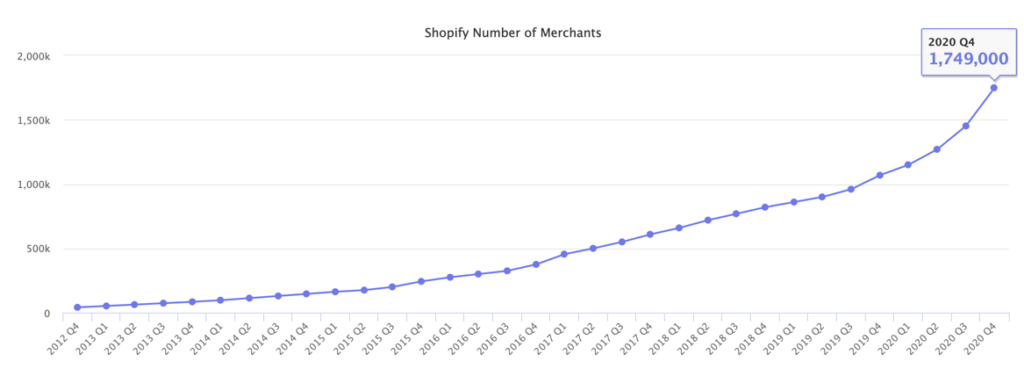
Top revenue-generating sites using Shopify as their ecommerce platform include The Bed Bath and Beyond Kitchen Store with over $7.2M in yearly revenue, Chipotle Farmers Market with $3.2M in revenue, and the Code Academy Shop with $2.6M per year. Other top contenders include the Carnival Cruise Line Merch Shop, the Thought Catalog Store, and The Points Guy Shop.
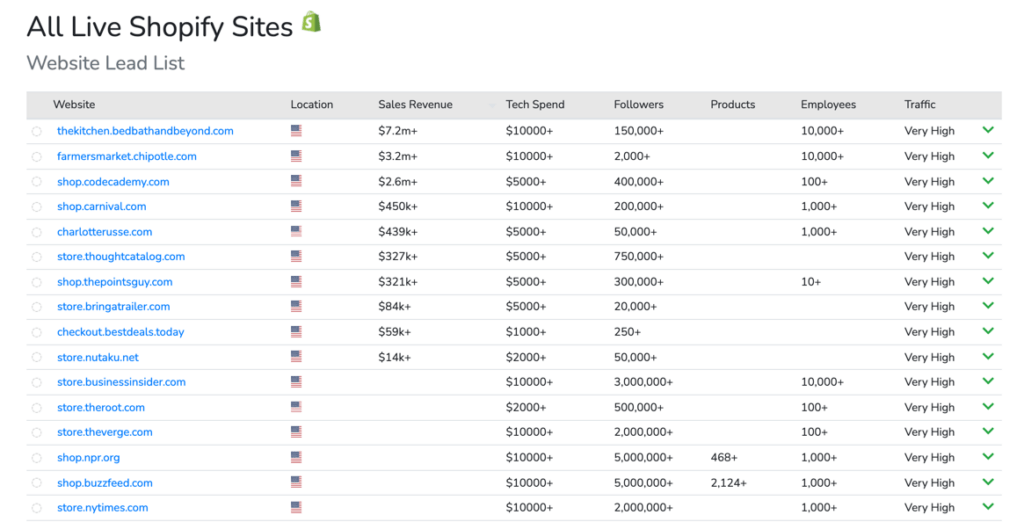
Top revenue generating sites using Shopify Plus include Nokia's India Mobile Shop with over $27M in annual revenue, Taylor Swift's website with over $2.7M per year, and the Chronicle Higher Education store with $7.1M+ in yearly revenue.
Regional Shopify Merchants
Shopify calls 175 countries home, seeing as how merchants from all of these countries use Shopify in some way. 50% of those merchants are from the US, accounting for over 874K merchants.
The Europe, Middle East, and Africa region boasts 25% of all merchants at 437K sellers. The Asia Pacific, Australia, and China region touts 15% of all Shopify merchants at 262K sellers. Canada has a lower number, which is surprising considering they founded Shopify in Canada. Canadian merchants account for 6% of the total merchant count at 104K sellers, while Latin America is at the bottom of the list with 69.9K sellers (4%).
Number of Consumers Who Buy from Shopify Stores
Do you ever wonder how many people actually go to and shop at Shopify stores?
According to Shopify, 457 millions people went to the stores and made a purchase. This was in 2020, showing an increase of 52.33% in consumer spending from the previous year.
Shopify buyers from 2019 counted 300 million. They saw 216 million in 2018 and 163 million in 2017.
Number of Apps and Themes on Shopify

Shopify hasn't grown its Theme Store that much, but rather they focus on curating a collection of quality themes with multiple style variants. Essentially, Shopify has maintained a list of 100 themes that they update every year. Many of the themes have two or three style variants that are drastically different from the original design, so we would argue that Shopify actually offers about 300 theme designs.
As for the App Store, this grows on a regular basis. The Shopify App Store has 7,000 apps available for merchants to download and use on their stores. There are 12 main categories with dozens of other subcategories. What's interesting is that the Shopify App Store nearly doubled its count from 2019 to 2020. They only had 3,700 apps in 2019.
Looking back, the Shopify App Store contained 900 apps in 2015, 1,400 apps in 2016, 2,300 apps in 2017, and 2,500 apps in 2018.
How Many People Does Shopify Employ?
Shopify states that it plans to continue hiring new developers, engineers, marketing associates, and contractors to expand upon its current enterprise. Way back in 2013, Shopify had 334 employees. That grew to almost 3,000 once 2017 came around and 5,000 in 2019.
As of the most recent data, Shopify employs about 7,000 people. This includes both employees and contractors.
Shopify Business Advancements
Shopify revenue reports don't only have charts, numbers, and stats about usership and revenue growth. They also talk about the most recent business advancements that have helped lead to revenue growth. This includes recently released products, new business partnerships, features, and even notable charity events.
Here are some of the most recent Shopify business advancements that factor into the overall Shopify revenue reports:
- Shopify created and launched a platform called Shopify Markets, which helps all of its merchants tap into cross-border customer relationships. Essentially, it provides a tailored experience for new markets if a merchant, per say, wants to make a website just for Germans, or one with Italian content. All Shopify Markets websites get consolidated in one unified view on the Shopify dashboard.
- Shopify rolled out its TikTok checkout feature, allowing merchants to link a TikTok account then link back from TikTok posts to their online store.
- Shopify released a Spotify channel for artists who want to link their Spotify accounts with a store.
- Shopify extended more generous terms to app developers following 2021.
- They expanded the Shopify Shipping operations to the UK.
- Shopify opened a brick-and-mortar store of its own in New York City, giving Shopify merchants a hands-on experience to learn about Shopify products, hardware, software solutions, and more.
- Shopify Capital increased its lending program to loan out about $393.6 million to merchants.
- Shopify launched a completely revamped POS Pro software with the Android system.
- Shopify rolled out its new Shopify Balance product, which is a money management solution for merchants. It gives merchants a unified dashboard for accessing their cash, while also providing a card for spending and rewards to use that card for business purposes.
- The Shopify Fulfillment Network saw a significant amount of growth with additions like product bundling, the tracking of inbound transfer shipments, and regional tax settings.
- Shopify made waves with its Global ERP Program, which gives ERP partners more access to the app store and direct integrations. Essentially, it lets larger companies like Oracle NetSuite, Microsoft, and Acumatica develop and integrate their own solutions to merge into the Shopify ecosystem. This is primarily to help out high-volume merchants that want to improve their control of data and workflows on a daily basis.
If you have any questions about Shopify revenue, net income, or would like to make some mentions about other Shopify statistics you've found, let us know in the comment section below!




Comments 0 Responses